The Place Where You Live: Wyoming's Red Desert
Air Date: Week of November 6, 2015
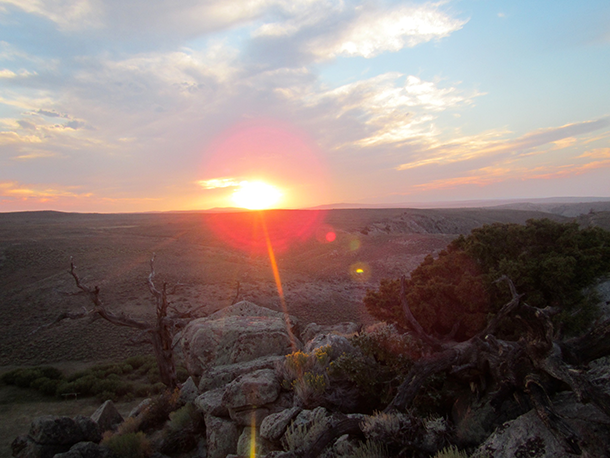
Wyoming’s Red Desert (Photo: Ann Stebner Steele)
Ann Stebner Steele grew up in Wyoming, riding horses and hunting pronghorn. As part of our ongoing series in collaboration with Orion Magazine, she brings us this audio essay about food, family, and the Red Desert that she loves.
Transcript
CURWOOD: We stay out on the vast western range now for another installment in the occasional Living on Earth/Orion Magazine series “The Place Where You Live.” Orion invites readers to submit essays to the magazine’s website and put their homes on a map, and we give some of them a voice.
[MUSIC: Edward Sharpe and The Magnetic Zeroes “Home” from Edward Sharpe and The Magnetic Zeroes (Rough Trade Records 2009)]
CURWOOD: Today’s essay evokes a time-honored ritual in a Wyoming landscape that Ann Stebner Steele and her family have ridden over and loved for decades.
(https://orionmagazine.org/place/wyomings-red-desert/)
STEELE: I am Wyoming born and raised, I’m the 4th generation of my family to grow up in Wyoming. Laramie, where I live is mostly basin and range kind of country, so we have the Snowy Range Mountains, and then really wide open plains with a lot of prairie type grass, and then the Red Desert which I write about in my essay is true high desert so it’s more sagebrush, a little bit hillier, and it breaks away into the Wind River Mountains. I am Ann Stebner Steele, and this is my essay about Wyoming’s Red Desert.
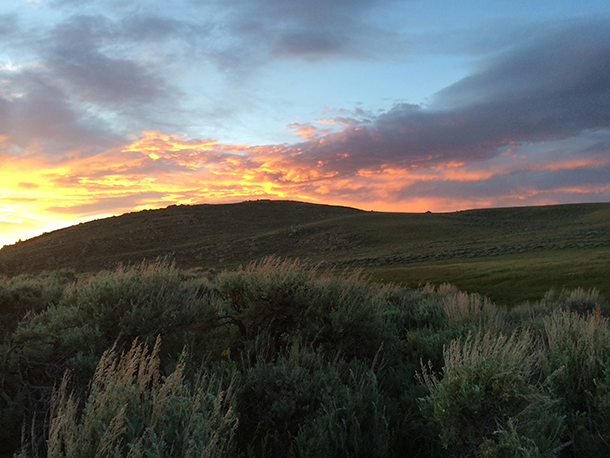
Sunset in Wyoming (Photo: Ann Stebner Steele)
[SOUNDS OF WIND, HORSES AND RUNNING WATER]
STEELE: First, the square that is Wyoming, the arbitrary lines that bisect geography. Then, just off center in the southern third of the state, the Red Desert, larger than the country of Wales, and within this high desert covered with sagebrush and grease-wood and scoured by wind and snow and sun, the Great Divide Basin opens. Note the Sweetwater River, a deep and surprising crack in a landscape of little water, too much wind, and dirt two-track roads that finger the ground like hairline fractures.
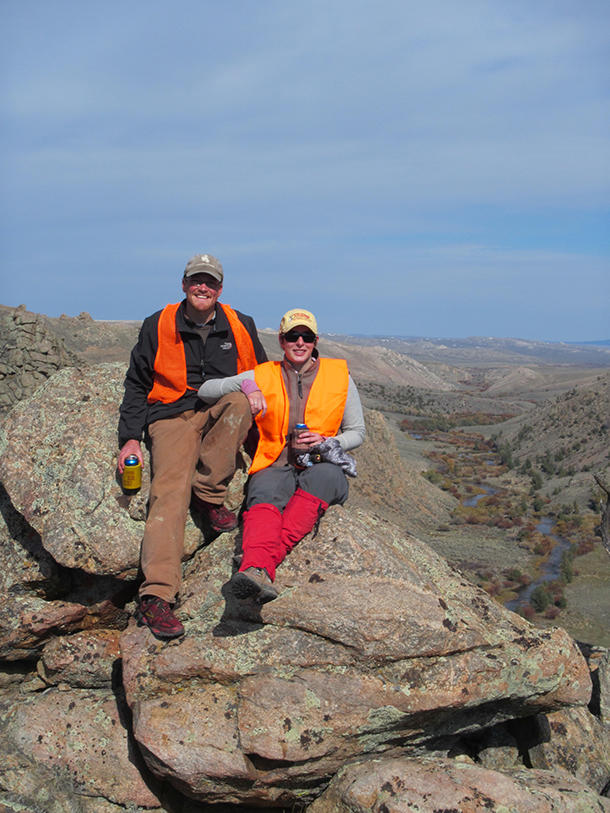
Ann and her husband (Photo: Ann Stebner Steele)
On the north side of the river, on a cooling fall evening, I kneel next to my brother, helping him field dress an antelope, the wind cutting sharp through the layers I wear, dark coming on fast as the sun sinks coral against the rough-edges of the sandstone and sage stretching away from us. We hurry to beat night and get back to camp and the fire’s orange heat, and I am wrist deep in the buck’s warm chest cavity before I realize that I have forgotten to put on gloves.
My brother and I were born in Rawlins, Wyoming, but we were raised in the Red Desert. These wide horizons, the sweep of sky against earth, are our home. My family has hunted antelope in this country for four generations, and the meat that we take ties us to the place as surely as the hours spent driving, walking, and studying its draws and valleys. In marrying me, my fiancé will also marry the desert, and in the years to come, he will join me in hunting, in dressing game in order to dress our table.
When he drives into camp tonight from his job in town, he will join my brother and me around the fire ring my parents built thirty years ago. Now, I feel with my thumb for my engagement ring, feel the metal encircling my finger. I hold my hand to the light. The three small diamonds and the gold band glint, muted by the richness of blood, the diamonds almost ruby in the failing light.
[MUSIC: Eddie Vedder“ Tuolumne”from Into the Wild soundtrack, (J Records, 2007)]
I grew up in a family that hunts. Both my mom’s father and my dad’s father loved hunting, it was a huge part of who they were and how they bonded with their children. And so it was through hunting and fishing as well that my grandparents first introduce my parents to the wild places. And then that kind of grew from there, and it started becoming about not just taking game, but really going into the place and forming a deep, deep connection to that place.
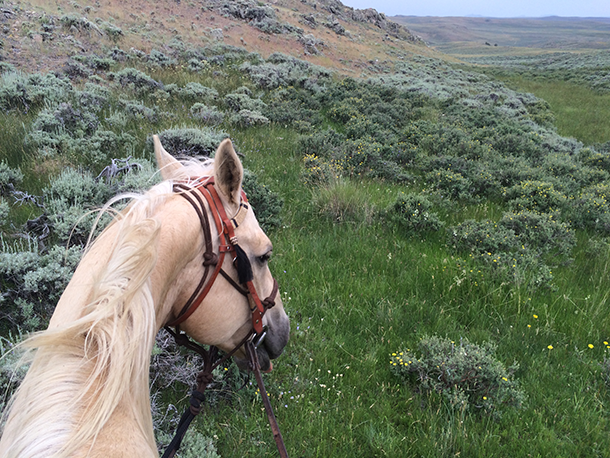
The view from atop Ann’s horse Tucker (Photo: Ann Stebner Steele)
Every time I’ve shot an antelope I have cried. And not in joy. Not because it was a big buck, or because of the thrill of the hunt, but because I’ve taken the life of something beautiful, and the finality of that act is unequivocal. You can’t get around it. And so for me hunting ties me more closely to that place because I am eating and animal that has lived and died at my hand in the place that I love.
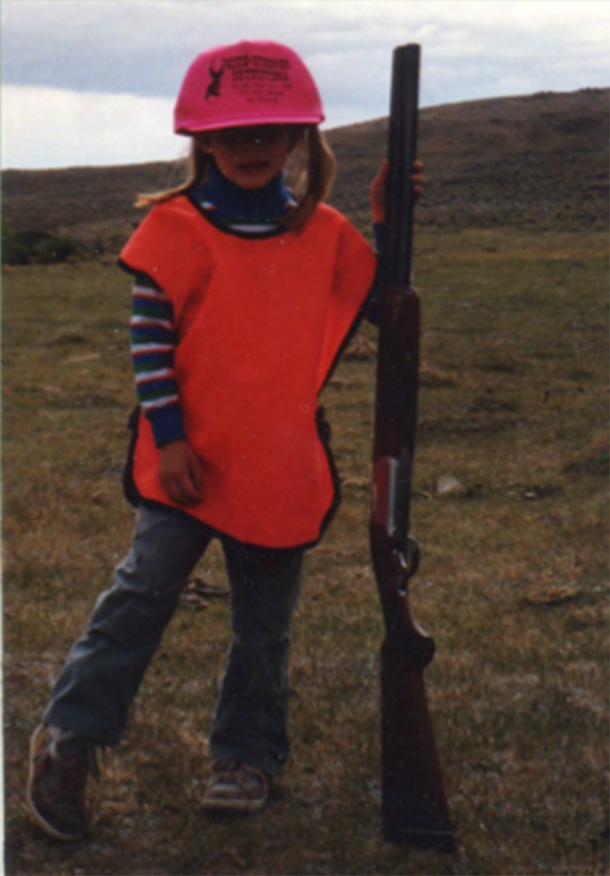
Hunting is a family tradition (Photo: Ann Stebner Steele)
I think it is that kind of connection that I learned from my parents, from having a really deep map of place in Wyoming that drew my husband into our family in a really big way. He grew up as a vegetarian. When he was in high school his rebellious stage was to order a hamburger at McDonalds. So there’s this mixing of our family traditions, but they come from I think the same place, which is a reverence and respect for landscape and for the animals we share it with, and an awareness that we have to be responsible to that connection and acknowledge it, if we are going to live well on this earth.
[MUSIC: Eddie Vedder, “Tuolumne” from Into the Wild soundtrack (J Records, 2007)]
CURWOOD: That’s Ann Stebner Steele and her essay about the Red Desert in Wyoming – and you can tell us about "The Place Where You Live," if you like. There’s more about Orion Magazine and how to submit your essay at LOE dot org.
Links
Living on Earth wants to hear from you!
Living on Earth
62 Calef Highway, Suite 212
Lee, NH 03861
Telephone: 617-287-4121
E-mail: comments@loe.org
Newsletter [Click here]
Donate to Living on Earth!
Living on Earth is an independent media program and relies entirely on contributions from listeners and institutions supporting public service. Please donate now to preserve an independent environmental voice.
NewsletterLiving on Earth offers a weekly delivery of the show's rundown to your mailbox. Sign up for our newsletter today!
 Sailors For The Sea: Be the change you want to sea.
Sailors For The Sea: Be the change you want to sea.
 The Grantham Foundation for the Protection of the Environment: Committed to protecting and improving the health of the global environment.
The Grantham Foundation for the Protection of the Environment: Committed to protecting and improving the health of the global environment.
 Contribute to Living on Earth and receive, as our gift to you, an archival print of one of Mark Seth Lender's extraordinary wildlife photographs. Follow the link to see Mark's current collection of photographs.
Contribute to Living on Earth and receive, as our gift to you, an archival print of one of Mark Seth Lender's extraordinary wildlife photographs. Follow the link to see Mark's current collection of photographs.
 Buy a signed copy of Mark Seth Lender's book Smeagull the Seagull & support Living on Earth
Buy a signed copy of Mark Seth Lender's book Smeagull the Seagull & support Living on Earth

